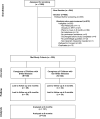A smoking cessation intervention for low-income smokers in the ED
- PMID: 25976268
- PMCID: PMC4480194
- DOI: 10.1016/j.ajem.2015.04.058
A smoking cessation intervention for low-income smokers in the ED
Abstract
Background: There is a high prevalence of smoking among caregivers who bring their children to the pediatric emergency department (PED) and even higher rates of tobacco smoke exposure (TSE) and related morbidity among their children. The PED visit presents an opportunity to intervene with caregivers, but it is unknown whether they are more likely to quit if their child has a TSE-related illness. We sought to examine a PED-based smoking cessation intervention and compare outcomes based on children's TSE-related illness.
Methods: A single-arm, prospective trial, with baseline, 3, and 6 month assessments was used in this study. Caregivers whose child had either a TSE-related (n=100) or non-TSE-related illness (n=100) were given a brief intervention consisting of counseling, referral to the Quitline, and free nicotine replacement therapy.
Results: Participants were 91.5% female, 50.5% African American, 100% Medicaid recipients, 30.8 years old, child age mean of 5.5 years, 90% highly nicotine dependent, and 60.3% and 75.8% allowed smoking in the home and car, respectively. At follow-up (65% retention), 80% reported quit attempts at 3 months and 89% between 3 and 6 months. There were significant decreases in number of cigarettes smoked, time to first cigarette, and smoking in the home and car. Quit rates were 12.2% at 3 months, 14.6% at 6 months, and 7.3% at both time points (50% biochemically confirmed). There were no significant differences in outcomes based on children's illness.
Conclusions: A brief PED-based smoking cessation intervention resulted in quit attempts and successful quits. However, the presence of a TSE-related illness did not result in different cessation outcomes.
Trial registration: ClinicalTrials.gov NCT01728038.
Copyright © 2015 Elsevier Inc. All rights reserved.
Conflict of interest statement
References
-
- Mahabee-Gittens EM, Gordon JS. Review of Adult Smoking Cessation Interventions Conducted in the Emergency Department and Application to the Pediatric Emergency Department Setting. US Respiratory Disease. 2008;4:125–8.
-
- Pitts SR, Niska RW, Xu J, Burt CW. National Hospital Ambulatory Medical Care Survey: 2006 emergency department summary. National health statistics reports. 2008:1–38. - PubMed
-
- Bernstein SL, Cannata M. Nicotine dependence, motivation to quit, and diagnosis in emergency department patients who smoke. Addict Behav. 2006;31:288–97. - PubMed
-
- Fagan P, Shavers VL, Lawrence D, Gibson JT, O’Connell ME. Employment characteristics and socioeconomic factors associated with disparities in smoking abstinence and former smoking among U.S. workers. J Health Care Poor Underserved. 2007;18:52–72. - PubMed
-
- Moolchan ET, Fagan P, Fernander AF, et al. Addressing tobacco-related health disparities. Addiction. 2007;102(Suppl 2):30–42. - PubMed
Publication types
MeSH terms
Substances
Associated data
Grants and funding
LinkOut - more resources
Full Text Sources
Other Literature Sources
Medical


